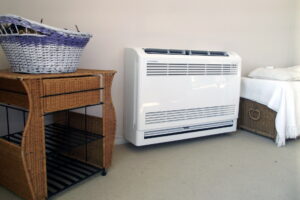A foul odor emanating from your air-source heat pump can be a cause for concern, often signaling the presence of mold. While troubleshooting the issue can be beneficial, it’s essential to emphasize that professional repair or maintenance is typically required for a thorough and long-lasting solution. In this guide, we’ll walk you through a step-by-step process to help homeowners identify and address mold-related issues in their heat pump.
Just make sure you rely on the experts to fix your issues with air source heating and cooling in Syracuse.
A Step By Step Guide
- Identify the Odor: The first step is to identify the type of odor you’re experiencing. If it’s a musty or moldy smell, there’s a possibility of mold growth in your heat pump. Mold can thrive in the moist and dark conditions present in heat pump systems.
- Turn Off the Heat Pump: For safety reasons, turn off your heat pump before inspecting it. This ensures that you won’t come into contact with any moving parts and allows the system to cool down.
- Inspect the Air Filters: Dirty or clogged air filters can contribute to mold growth. Remove the filters and inspect them for dirt, dust, and mold. If they appear dirty or moldy, replace them with new ones. Regularly changing air filters is a crucial aspect of preventing mold issues in your heat pump.
- Check the Condensate Drain: The condensate drain is responsible for removing excess moisture from the heat pump. A clogged drain can lead to water accumulation and mold growth. Inspect the drain for blockages and clear any debris that may be hindering proper drainage.
- Clean the Coils: The coils in your heat pump play a vital role in the heat exchange process. Over time, dirt and dust can accumulate on the coils, providing an ideal environment for mold growth. Use a soft brush or vacuum cleaner to gently clean the coils, being careful not to damage them.
- Look at Your Ductwork: Mold can also develop in the ductwork of your heat pump system. Inspect the ducts for any visible signs of mold, such as discoloration or a musty smell. If you suspect mold in the ducts, it’s crucial to consult with a professional HVAC technician for a thorough inspection and cleaning.
- Invest in UV Lights: Consider installing ultraviolet (UV) lights in your heat pump system. UV lights can help kill mold and bacteria, preventing their growth within the system. Consult with an HVAC professional to determine the appropriate placement and type of UV lights for your heat pump.
- Schedule Professional Maintenance: While these DIY steps can address some common mold-related issues, it’s crucial to recognize that professional maintenance is often necessary for a comprehensive solution. HVAC technicians have the expertise and tools to perform a thorough inspection, clean hard-to-reach areas, and ensure the overall efficiency of your heat pump.
Identifying and addressing mold issues in your air-source heat pump is a crucial aspect of maintaining a healthy and efficient HVAC system. While some troubleshooting steps can be taken by homeowners, it’s important to stress the necessity of professional repair or maintenance for a long-lasting and effective solution. Consulting with an HVAC professional ensures that your heat pump is not only free from mold but also operating at its peak efficiency.
Contact NP Environmental to have your moldy heat pump fixed up and cleaned properly.

